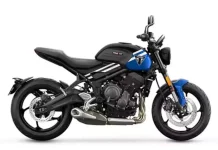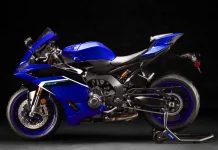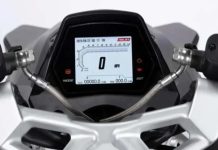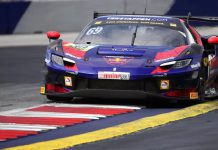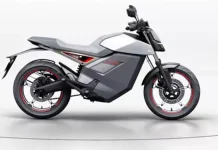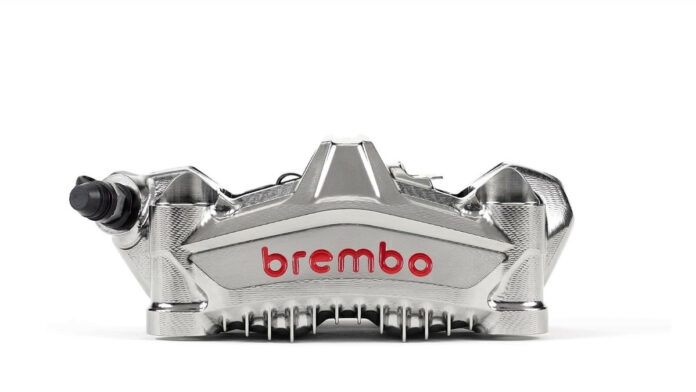Brembo’s GP4-MotoGP
The advancements in braking technology, particularly by Brembo, are quite impressive and crucial for high-performance biking. The new GP4-MotoGP callipers, introduced for the 2024 model year, are a standout example of this evolution.
Here is a summary of the Brembo GP4-MotoGP brake calliper:
- High-performance offering for street use
- Makes use of technology derived directly from MotoGP
- Oblique pad slide boosts braking power with minimal lever force
- Reduces drag and pad wear
- Ventilation fins integrated into the outer body of the caliper
- Racing pistons improve thermal exchange
- Machined from a solid billet of aluminium
- Ribbed design on the front section
- Nickel-coated treatment on the pistons enhances performance at high temperatures


High-Performance
Here are some key features and innovations:
- Oblique Pad Slide: This feature is directly derived from MotoGP technology. It significantly boosts braking power while requiring minimal lever force. This efficiency is paramount in high-performance settings.
- Reduced Drag and Pad Wear: The design ensures instant pad release when the lever is released, minimizing drag and reducing pad wear, which is vital for both performance and longevity.
- Ventilation Fins and Racing Pistons: Brembo incorporates ventilation fins in the outer body of the calliper for cooling, essential for maintaining performance and longevity. The racing pistons improve thermal exchange, allowing air to circulate more freely, which is especially beneficial at high speeds.
- Aesthetic Appeal: While these features are engineered for performance, they also have a visually appealing aspect, particularly on high-performance superbikes and hyper-naked.
- Construction: Like other Brembo high-performance callipers, the GP4-MotoGP is machined from a solid billet of aluminium. This process retains the aluminium’s grain, ensuring lightweight yet durable construction.
- Superior Stability and Brake Feel: The GP4 monobloc calliper offers superior stability and brake feel due to its construction with no joints, eliminating potential failure zones.
- Ribbed Design for Added Rigidity: The front section of the calliper features a ribbed design that holds the four aluminium pistons securely, even under heavy loads.
- Nickel-Coated Pistons: The nickel-coated treatment on the pistons enhances performance at high temperatures and reduces friction, thereby enhancing brake feel.
MotoGP Technology with Enhanced Safety
Impact on MotoGP Bikes
The introduction of Brembo’s GP4-MotoGP brake callipers can have a substantial impact on MotoGP bikes, enhancing their performance, safety, and reliability in several key areas:
- Enhanced Braking Performance: The GP4-MotoGP’s advanced features, like the oblique pad slide and efficient thermal management, enable more powerful and responsive braking. In a sport where every millisecond counts, this can significantly improve lap times and overall competitiveness.
- Improved Safety: High-performance braking is crucial for rider safety, particularly in MotoGP where speeds are extremely high. The GP4-MotoGP callipers’ efficient heat dissipation and reliable performance under stress contribute to a safer racing environment.
- Reduced Brake Fade: The advanced cooling features of the callipers, including ventilation fins and racing pistons, help prevent brake fade during races. Consistent braking performance throughout a race is crucial for both safety and maintaining competitive speeds.
- Durability and Reliability: The solid aluminium construction and ribbed design for additional rigidity mean these callipers are built to withstand the extreme conditions of MotoGP racing. This durability is key in a sport where equipment failure can have significant consequences.
- Better Brake Feel and Control: The nickel-coated pistons and monobloc construction offer improved brake feel and control. This is vital for riders who need precise braking input to navigate tracks at high speeds and execute tight manoeuvres.
- Potential for Faster Cornering: Improved braking technology can allow riders to brake later and harder before corners, potentially enabling faster cornering speeds. This can be a game-changer in races where cornering speed and agility are critical.
- Aesthetic and Brand Appeal: The visually striking design of the GP4-MotoGP callipers can enhance the overall aesthetic of the bikes, which is important for team branding and sponsorships.
- Adaptability to Different Circuits and Conditions: The versatility and performance of these callipers can be advantageous across various circuits and under different weather conditions, which is essential in a global sport like MotoGP with diverse racing environments.
Brembo’s GP4-MotoGP brake callipers represent a significant technological advancement with the potential to impact MotoGP racing profoundly. By improving braking performance, safety, and reliability, these callipers can contribute to better race outcomes, higher speeds, and enhanced rider safety.
Superior Braking Power
The Brembo GP4-MotoGP brake callipers, while offering several advantages, also come with potential drawbacks. Here’s a breakdown of the pros and cons:
Pros
- Enhanced Braking Performance: They provide superior braking power and responsiveness, crucial for high-speed and performance-focused motorcycles, especially in racing scenarios.
- Improved Safety: Advanced braking systems contribute to overall rider safety, reducing the risk of accidents due to brake failure or insufficient stopping power.
- Reduced Brake Fade: With improved cooling mechanisms, these calipers are less prone to brake fade, maintaining consistent performance even under strenuous conditions.
- Durability and Longevity: The construction from a solid billet of aluminum and the ribbed design for added rigidity enhances the durability and lifespan of the brake callipers.
- Better Brake Feel and Control: The design and materials used (like nickel-coated pistons) offer a superior brake feel, allowing for more precise control, which is vital in high-speed manoeuvres.
- Aesthetically Pleasing: Their visually appealing design can enhance the overall look of high-performance motorcycles.
- Technological Advancements: Incorporating technologies derived from MotoGP provides cutting-edge performance enhancements.
Cons
- Cost: High-performance braking systems like the GP4-MotoGP are typically more expensive than standard brakes, impacting the overall cost of the motorcycle or the cost of upgrades.
- Complexity and Maintenance: Advanced systems may require more complex maintenance and servicing, which might need specialized skills and equipment.
- Weight: Despite being made from lightweight materials, high-performance brake systems can be heavier than simpler ones, potentially affecting the bike’s overall weight balance.
- Overperformance for Regular Use: For everyday riders or in non-racing scenarios, such advanced braking power may not be necessary, leading to an overinvestment in performance capabilities.
- Compatibility and Integration: Upgrading to these callipers may require additional modifications to the motorcycle to ensure compatibility and optimal performance.
- Specialized Usage: The design and features are tailored for high-speed and racing conditions, which might not translate to added benefits in normal road use.
Conclusion
In conclusion, while the Brembo GP4-MotoGP brake callipers offer significant advantages in performance, safety, and durability, they also come with considerations like cost, complexity, and the potential for being over-spec for regular use. Their suitability largely depends on the specific requirements and contexts of the riders or racing teams.
These innovations by Brembo, particularly in the GP4-MotoGP callipers, demonstrate the ongoing advancements in motorcycle brake technology, focusing on performance, safety, and durability.



